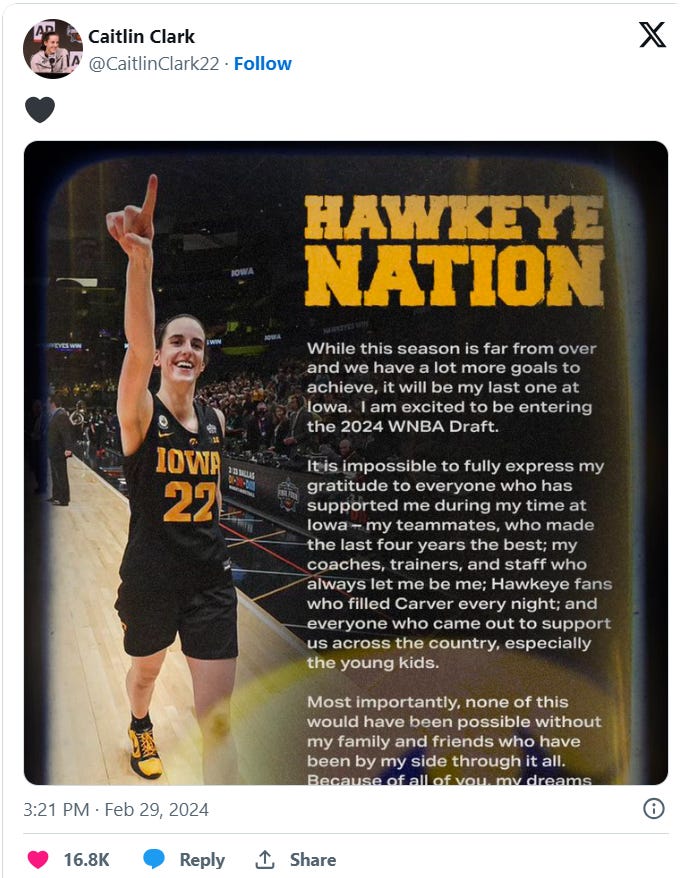How Good Will Caitlin Clark Be In the WNBA Right Away?
Let's look at how quickly WNBA No. 1 draft picks develop into stars.
To no one’s great surprise, record-breaking NCAA superstar Caitlin Clark declared for the WNBA Draft on Thursday afternoon, foregoing her final year of college eligibility at Iowa — and presumably paving her way to be taken by the Indiana Fever with the first overall pick this April.
With Clark heading to the pros, I was wondering just what kind of impact we can expect her to make early in her WNBA career.
To that end, I gathered data from Basketball-Reference on how many wins each player generated each season. I’m calculating what I like to call “consensus wins” — a mix of multiple popular stats, to make sure different approaches are factored into our evaluation process. In the WNBA,1 I use Win Shares and Estimated Wins Added, which sets Player Efficiency Rating (PER) to a Win Shares-like scale. Averaging those measures together,2 and pro-rating every season to the WNBA’s current schedule length of 40 games, we finally have an estimate of how much value teams got out of every player.
For reference’s sake, 5.0 consensus wins added is a really good year — only 14 players cleared that threshold last season. Get closer to 10.0, and you’re an MVP candidate. Hover around 12.0 — like A'ja Wilson (12.3) and Breanna Stewart (11.7) did last year — and it’s one of the best seasons in league history. (Get closer to 15.0, and you’re Cynthia Cooper.) Here’s what every No. 1 pick in the WNBA Draft produced in the first 5 seasons after being selected:
On average, a top pick creates about 5 wins on average over their first few seasons, before ramping up towards 6 wins and beyond.3 About a third of top picks create 6.5 or more wins as rookies, and about 14% create 7 or more wins.
But it has taken recent rookies a bit longer to find their strides: Although Wilson (the No. 1 pick in 2018) and Aliyah Boston (No. 1 in 2023) were instantly great, Atlanta’s Rhyne Howard was just solid (3.7 wins, 22nd in league) in her debut, while Kelsey Plum, Jackie Young, Sabrina Ionescu and Charli Collier averaged just 0.5 wins apiece in their rookie years. All eventually picked up their production — save for Collier, who was waived last May and didn’t play in the league at all last season — but these might serve as cautionary tales for setting Clark’s expectations too high.
(Somewhere, Sheryl Swoopes is nodding.)
Then again, Clark is the most hyped WNBA prospect since Candace Parker — if not ever, full stop — and Parker immediately posted 10.6 consensus wins, the most by any No. 1 pick as a rookie, while winning MVP honors. Though they are very different players, it wouldn’t shock anybody if Clark did something similar next season.
Or at the very least, we might expect her to contribute something on par with her future Fever teammate, Boston, who ranked eighth in the league in wins created right away to begin her career. From there, maybe Clark can challenge the best of the rest on our list above: Maya Moore’s second and fourth seasons, Lauren Jackson’s out-of-this-world third year,4 and the incredible performance of Nneka Ogwumike in her fifth WNBA season.
Clark took the first step toward all of that this week, even though she still has unfinished business to accomplish at the college level first.
Filed under: WNBA, College Basketball
Which lacks some of the fancier plus/minus-style stats at Basketball-Reference.
And adding a team adjustment that ensures the total EWA for a team also matches its total WS (which is itself based on a team’s point differential).
Interestingly, men’s top picks since 2000 have only created about 2.0 Win Shares per 40 team games in their rookie years.
Jackson’s 12.6 consensus wins per 40 games in 2003 is the most by any top pick in any of their first 5 career seasons.






